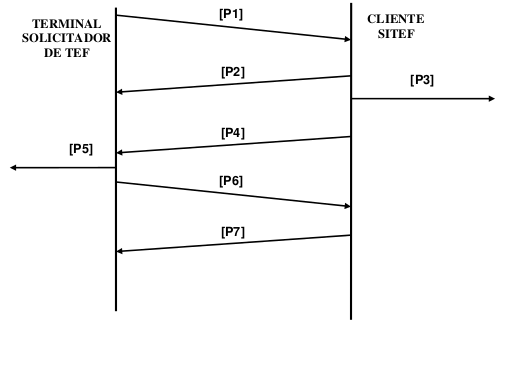Technical information
Communication between the SiTef Client and the TEF Request Terminal#
The TEF requesting Terminal will be responsible for carrying out all tasks relevant to the sale and legislation ECF, including printing the tax coupon and TEF coupon. At the end of the sale, if the payment method chosen to use the SiTef Client, the TEF requesting Terminal will activate the SiTef Client (through recording of a file). The exchange of information between systems is done through the exchange of standard messages. It is modality was defined to allow greater independence between systems.
Below is the data flow between the TEF requesting Terminal and the SiTef Client and also the description detailed description of the tasks to be performed by the TEF requesting Terminal when using TEF functions. Each of the 6 stages of the information flow outlined above will now be described in detail. How can you To be clear, the SiTef Client uses two directories to communicate with the TEF requesting Terminal. These directories are: C:\Cliente\Req, which is reserved for files generated by the TEF requestor Terminal that must be handled by the SiTef Client; and C:\Cliente\Resp, which contains files generated by the SiTef Client that must be processed by the TEF requesting Terminal.

➢ [P1]: At this stage, the TEF requesting Terminal must make a TEF transaction request to the Customer SiTef. This request is made by generating the IntPos.001 file in the C:\Cliente\Req directory. O The content of this file varies according to the type of transaction desired and will be described later.
➢ [P2]: At this stage, the SiTef Client will confirm to the TEF requesting Terminal the receipt of the request by generating the IntPos.STS file in the C:\Cliente\Resp directory. Again, the contents of this file will be described below.
➢ [P3]: This step is performed only by the SiTef Client, which will capture the additional data necessary to transaction, read magnetic cards, if necessary, and send the transaction to payment administrators. card and receive the answer.
➢ [P4]: In this step the SiTef Client will generate the file containing the response to the transaction. This file is the IntPos.001, which will be generated in the C:\Cliente\Resp directory. This file, among other information, will contain the Tef coupon that must be printed, if the requested transaction generates a coupon.
➢ [P5]: At this stage, the TEF requesting Terminal must print the TEF coupon, if it exists, and show the necessary messages to the operator of the TEF requesting Terminal and to the Customer.
➢ [P6]: In this step, the TEF requesting Terminal must generate the IntPos.001 file, in the directory C:\Cliente\Req, and this file must contain the EFT coupon printing status.
➢ [P7]: At this stage, the SiTef Client will confirm to the TEF requesting Terminal the receipt of the status of the printing the TEF coupon by generating the IntPos.STS file in the C:\Cliente\Resp directory.
Regarding these steps described above, there are three important observations to be made:
In steps [P1] and [P6] you must not directly create the file in the folder \Client\Req. You must create the file with the name IntPos.tmp, save the necessary fields, close the file and only at the end rename it to IntPos.001.
Transactions that do not require printing a TEF coupon, the flow ends at [P4]. Otherwise, it goes to [P7].
There is no way to identify, just through the type of transaction, whether or not a TEF coupon will be printed, and therefore, the TEF requesting Terminal must always check all information in the file received in [P4]. The contents of these files and all others in this stream will be described below.